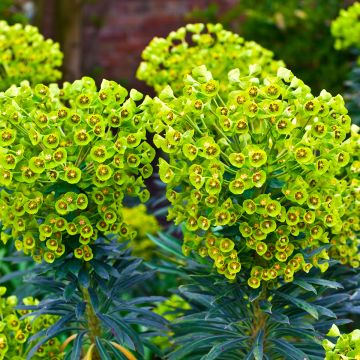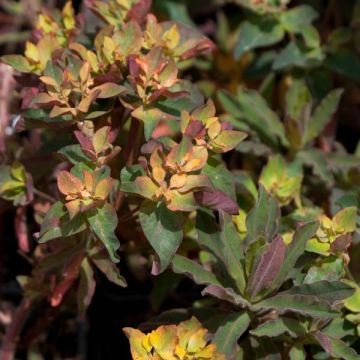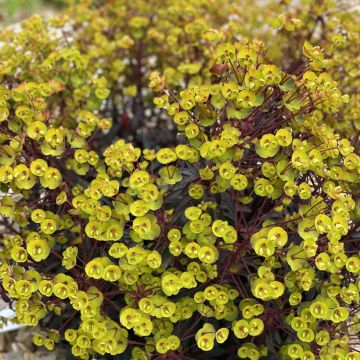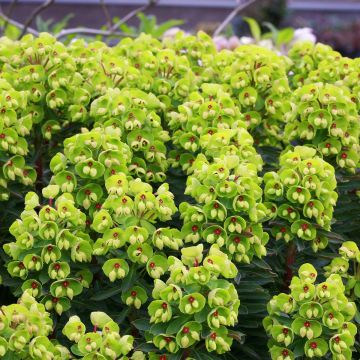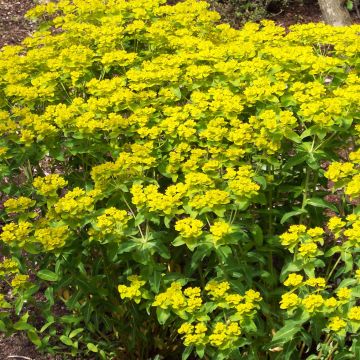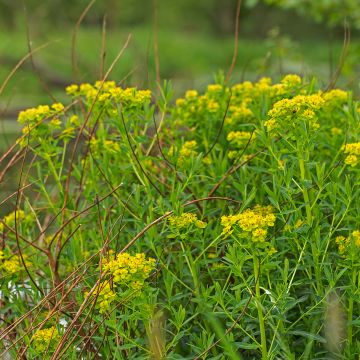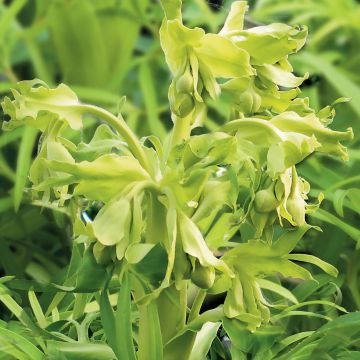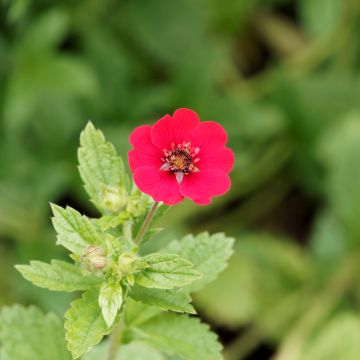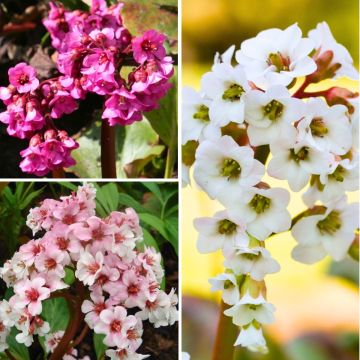

Euphorbia polychroma Variegata - Spurge
Euphorbia polychroma Variegata - Spurge
Euphorbia polychroma Variegata
Cushion Spurge
First step taken free replacement on the spot
Francis , 04/06/2021
Why not try an alternative variety in stock?
View all →This plant carries a 12 months recovery warranty
More information
We guarantee the quality of our plants for a full growing cycle, and will replace at our expense any plant that fails to recover under normal climatic and planting conditions.
From €5.90 for pickup delivery and €6.90 for home delivery
Express home delivery from €8.90.
Delivery to Corse prohibited: UE law prohibits the import of this plant from mainland France to Corse as part of the fight against Xylella fastidiosa. Please accept our sincere apologies.
More information

Does this plant fit my garden?
Set up your Plantfit profile →
Description
The Euphorbia polychroma 'Variegata' is a very pretty selection of polychrome spurge, with a grey-green-blue foliage strongly margined with cream. The plant forms an elegant, spreading, and bushy round clump, which comes to life in spring with a variegated flowering, predominantly chrome yellow, above its very soft hairy foliage. This medium-sized perennial is very hardy and easy to grow in a porous not too dry soil. It is irreplaceable for illuminating a slightly shaded area, in a rock garden or border. It will thrive in full sun or partial shade.
The polychrome spurge is a deciduous perennial native to central and southern Europe. It belongs to the vast family of euphorbiaceae. It presents itself as a bushy and spreading clump, a little wider than tall, occupying 50 cm (20in) of ground and slowly widening. Nestled at the base of the stump, new buds grouped around the collar appear in spring. These hairy stems elongate rapidly. They bear deciduous leaves covered with small silky hairs, which turn pretty shades of red before disappearing. The flowering takes place in April-May, sometimes until June. The small flowers, surrounded by bracts very bright yellow-green make up an inflorescence of 4 to 8 cm (2 to 3in) in diameter appearing at the end of each robust stem. In this variety, even the yellow bracts are variegated with green and cream. This plant self-seeds quite easily in light soil.
The 'Variegata' polychrome spurge is used as a border or in a mass planting, in sunny or partial shade. Our advice is to associate it with brightly colored tulips, or on the contrary, white tulips, to give contrast to your flower beds. It can also be planted at the base of evergreen shrubs (conifers, boxwood, myrtle) and among perennials that bloom at the same time, such as Columbines, Phlox divaricata, Campanulas, Geranium phaeum, Lamium, Ajuga reptans, Viola cornuta, and many others. An association with purple foliage like that of Cotinus coggygria 'Royal Purple' or Prunus cistena is interesting, as well as a marriage with the blue flowers of ceanothus, Caryopteris clandonensis 'Grand Bleu' or Ceratostigma willmotianum. Note that this plant, while preferring a bit of moisture at its base, can tolerate occasional drought.
With about 8000 species, euphorbias represent one of the richest genera on the planet. Few of them can acclimate in the garden, but rest assured, there is something to satisfy both the most demanding collector and the amateur gardener who wants to garden without worries with perennial and hardy euphorbias for shade or sun, cool or hot, dry or wet. It's just a matter of choosing wisely.
Report an error about the product description
Euphorbia polychroma Variegata - Spurge in pictures
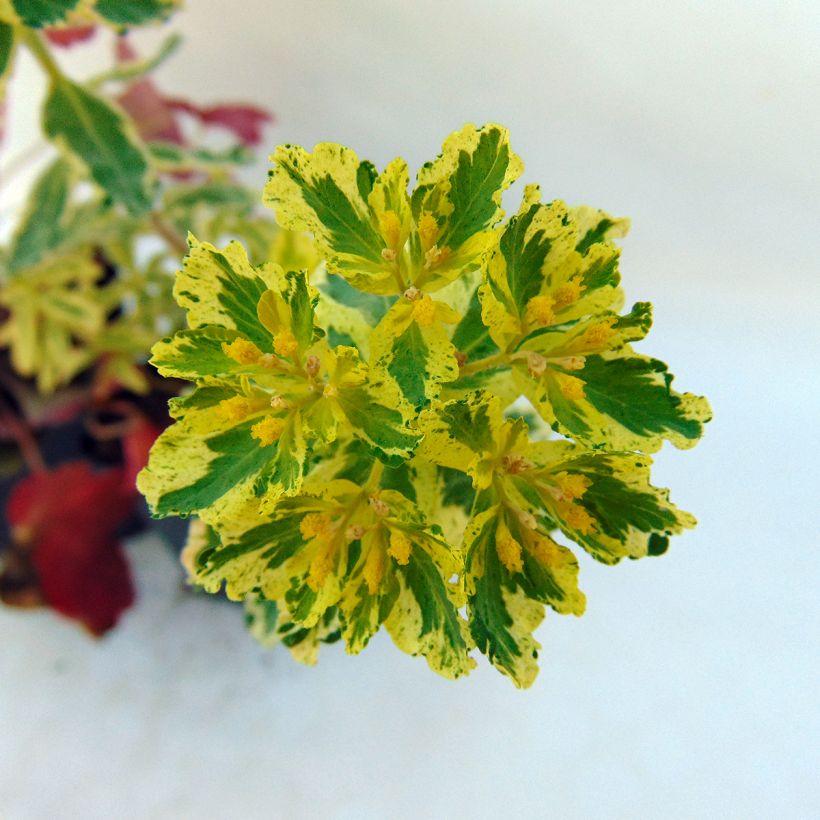



Flowering
Foliage
Plant habit
Safety measures
Botanical data
Euphorbia
polychroma
Variegata
Euphorbiaceae
Cushion Spurge
Cultivar or hybrid
atteintescutaneomuqueuses
Cette plante peut provoquer l'apparition de réactions cutanées indésirables, une atteinte des yeux, ou des difficultés respiratoires si elle est ingérée.
Ne la plantez pas là où de jeunes enfants peuvent évoluer. Evitez tout contact avec la peau: privilégiez l'emploi de gants pour la manipuler. En cas de contact, lavez-vous soigneusement les mains et rincez abondamment à l'eau la zone concernée. Lavez les vêtements entrés en contact. En cas de réaction cutanée, contactez votre médecin ou le centre antipoison le plus proche de chez vous. En cas d'atteinte étendue ou de difficultés respiratoires, appelez immédiatement le 15 ou le 112.Pensez à conserver l'étiquette de la plante, à la photographier ou à noter son nom, afin de faciliter le travail des professionnels de santé.
Davantage d'informations sur https://plantes-risque.info
Other Euphorbia - Spurge
Planting and care
Plant the 'Variegata' polychrome euphorbia in spring or autumn, in ordinary soil, rather moist, very porous and well-drained, sandy and fairly rich in humus. This perennial plant nevertheless tolerates drought quite well. Choose a preferably semi-shaded exposure, as that's what it prefers (the bright yellow of its flowers will stand out better there). Its hardiness is excellent, below -15°C.
Planting period
Intended location
Care
-
, onOrder confirmed
Reply from on Promesse de fleurs
Spring flowering perennials
Haven't found what you were looking for?
Hardiness is the lowest winter temperature a plant can endure without suffering serious damage or even dying. However, hardiness is affected by location (a sheltered area, such as a patio), protection (winter cover) and soil type (hardiness is improved by well-drained soil).

Photo Sharing Terms & Conditions
In order to encourage gardeners to interact and share their experiences, Promesse de fleurs offers various media enabling content to be uploaded onto its Site - in particular via the ‘Photo sharing’ module.
The User agrees to refrain from:
- Posting any content that is illegal, prejudicial, insulting, racist, inciteful to hatred, revisionist, contrary to public decency, that infringes on privacy or on the privacy rights of third parties, in particular the publicity rights of persons and goods, intellectual property rights, or the right to privacy.
- Submitting content on behalf of a third party;
- Impersonate the identity of a third party and/or publish any personal information about a third party;
In general, the User undertakes to refrain from any unethical behaviour.
All Content (in particular text, comments, files, images, photos, videos, creative works, etc.), which may be subject to property or intellectual property rights, image or other private rights, shall remain the property of the User, subject to the limited rights granted by the terms of the licence granted by Promesse de fleurs as stated below. Users are at liberty to publish or not to publish such Content on the Site, notably via the ‘Photo Sharing’ facility, and accept that this Content shall be made public and freely accessible, notably on the Internet.
Users further acknowledge, undertake to have ,and guarantee that they hold all necessary rights and permissions to publish such material on the Site, in particular with regard to the legislation in force pertaining to any privacy, property, intellectual property, image, or contractual rights, or rights of any other nature. By publishing such Content on the Site, Users acknowledge accepting full liability as publishers of the Content within the meaning of the law, and grant Promesse de fleurs, free of charge, an inclusive, worldwide licence for the said Content for the entire duration of its publication, including all reproduction, representation, up/downloading, displaying, performing, transmission, and storage rights.
Users also grant permission for their name to be linked to the Content and accept that this link may not always be made available.
By engaging in posting material, Users consent to their Content becoming automatically accessible on the Internet, in particular on other sites and/or blogs and/or web pages of the Promesse de fleurs site, including in particular social pages and the Promesse de fleurs catalogue.
Users may secure the removal of entrusted content free of charge by issuing a simple request via our contact form.
The flowering period indicated on our website applies to countries and regions located in USDA zone 8 (France, the United Kingdom, Ireland, the Netherlands, etc.)
It will vary according to where you live:
- In zones 9 to 10 (Italy, Spain, Greece, etc.), flowering will occur about 2 to 4 weeks earlier.
- In zones 6 to 7 (Germany, Poland, Slovenia, and lower mountainous regions), flowering will be delayed by 2 to 3 weeks.
- In zone 5 (Central Europe, Scandinavia), blooming will be delayed by 3 to 5 weeks.
In temperate climates, pruning of spring-flowering shrubs (forsythia, spireas, etc.) should be done just after flowering.
Pruning of summer-flowering shrubs (Indian Lilac, Perovskia, etc.) can be done in winter or spring.
In cold regions as well as with frost-sensitive plants, avoid pruning too early when severe frosts may still occur.
The planting period indicated on our website applies to countries and regions located in USDA zone 8 (France, United Kingdom, Ireland, Netherlands).
It will vary according to where you live:
- In Mediterranean zones (Marseille, Madrid, Milan, etc.), autumn and winter are the best planting periods.
- In continental zones (Strasbourg, Munich, Vienna, etc.), delay planting by 2 to 3 weeks in spring and bring it forward by 2 to 4 weeks in autumn.
- In mountainous regions (the Alps, Pyrenees, Carpathians, etc.), it is best to plant in late spring (May-June) or late summer (August-September).
The harvesting period indicated on our website applies to countries and regions in USDA zone 8 (France, England, Ireland, the Netherlands).
In colder areas (Scandinavia, Poland, Austria...) fruit and vegetable harvests are likely to be delayed by 3-4 weeks.
In warmer areas (Italy, Spain, Greece, etc.), harvesting will probably take place earlier, depending on weather conditions.
The sowing periods indicated on our website apply to countries and regions within USDA Zone 8 (France, UK, Ireland, Netherlands).
In colder areas (Scandinavia, Poland, Austria...), delay any outdoor sowing by 3-4 weeks, or sow under glass.
In warmer climes (Italy, Spain, Greece, etc.), bring outdoor sowing forward by a few weeks.

































